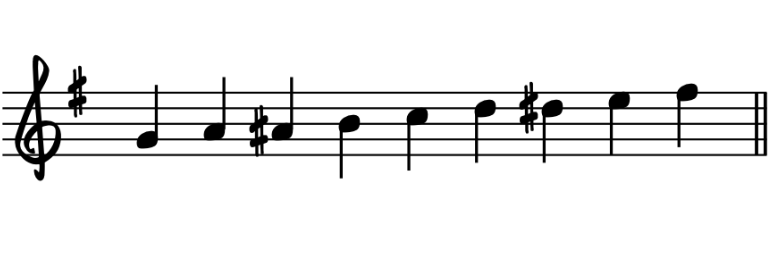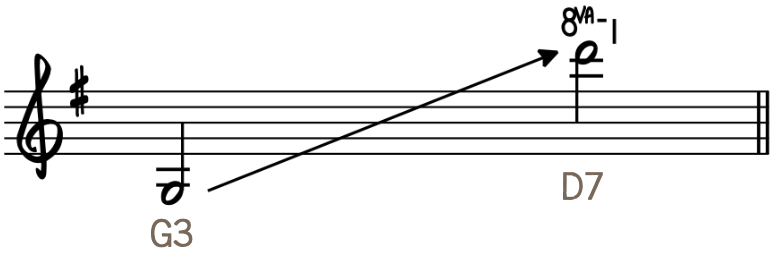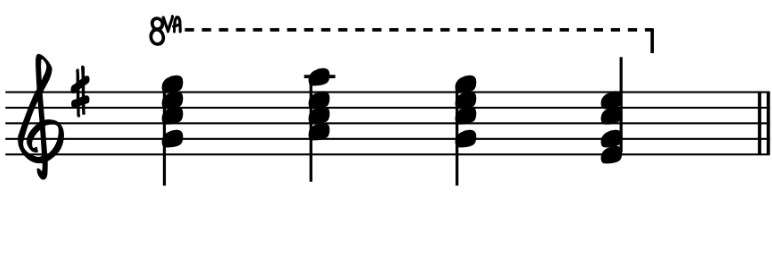4 Storytelling Tips for an Epic Piano Solo
Learning Focus
Music Style
Free Lessons
Get free weekly lessons, practice tips, and downloadable resources to your inbox!
Many piano students’ ultimate musical goal is to be able to improvise freely like a pro. But what if that goal is not specific enough? After all, if you want to play like a pro, then you have to think like a pro too! For mature performers, ingredients such as scales and licks are rarely top of mind when soloing. Instead, their attention is aimed in an entirely different direction. In today’s Quick Tip, 4 Storytelling Tips for an Epic Piano Solo, Jonny May shares how the best improvisors are also amazing storytellers! You’ll learn:
- Intro to Piano Soloing as Storytelling
- Lesson Overview & Musical Materials
- Organizing Your Improv Story Into Chapters
Intro to Piano Soloing as Storytelling
Perhaps you’re wondering how storytelling relates to musical improvisation. In fact, you may even be downright skeptical of the proposition. After all, isn’t that mixing artistic mediums? Not necessarily.
If your concept of storytelling is limited to reading a book out loud, then that might not make you a better improvisor per se. However, if you’re a parent (or an aunt, or an uncle or big sibling), then you know that kids really enjoy storytime—and therein lies the heart of the matter!
As soloists, we want to connect with our listeners in such a way that they actually enjoy our playing, right? In that regard, storytelling is a profoundly helpful paradigm for improvisors. After all, what is it that makes a child’s eyes light up while a story is being told? Isn’t it the deliberate pacing, the emphatic repetition, the changes in volume and inflection, the humor? Well, all of these narrative performance techniques can be replicated on our instrument. But first, we need to get our minds to think beyond music theory. That’s the point of today’s lesson!
Of course, you’ll have to use the rudiments of music when you’re telling our story. However, if you want to make a meaningful and memorable connection with your listeners, then you may need to reframe how you think about your ingredients. It’s not so much about what you play as it is about how they respond to what you play.
Lesson Overview & Musical Materials
In today’s piano storytelling lesson, we’ll explore improvisation through the lens of a story arc (aka narrative arc). In particular, we’ll aim to construct our solo according to a story arc that is organized into five categories or chapters:
- Exposition
- Introducing Tension
- Rising Action
- Dramatic Development
- Climax & Resolution
Applying the mental framework of a story arc to the art of instrumental improvisation can be a paradigm shift for many students. For instance, it immediately forces a soloist to think creatively in terms of pacing, tone color, range and texture. Likewise, this framework minimizes a student’s left-brained preoccupation with music theory that is largely irrelevant to their listeners. After all, audiences are not nearly as moved by what you play as they are by how you play—the notes are secondary! (That is not to say that the notes don’t matter, but they probably don’t matter to the extent that most students obsess over them).
Throughout today’s lesson, we’ll practice improvising over the primary chord progression from Bruce Hornsby’s popular 1986 song, “The Way It Is.” This progression appears below in the original key of G major, along with a harmonic analysis of the chord changes.
“The Way It Is Progression”

The sheet music notation above is clipped from the PDF that coincides with today’s piano tutorial. If you’re a PWJ member, you can download and print this sheet music from the bottom of this page after logging in with your membership. In addition, PWJ members also have access to our Smart Sheet Music, which allows for easy transposition and playback of all the lesson sheet content.
Throughout this lesson, we’ll focus on broad narrative considerations for pop piano soloing. However, if you’re looking to capture the essence of that Bruce Hornsby piano sound, the be sure to check out the following Quick Tip:
🔎 How to Play Piano Like Bruce Hornsby (Int)
Left Hand Accompaniment Patterns
After you’ve identified the chord progression of a song, the next step is to arrange the chords for piano in a manner that establishes a style and tempo. Since the focus of today’s lesson centers on improvisation, our accompaniment patterns are arranged for left-hand only.
The following pop piano accompaniment patterns are recorded at medium-fast tempo of 110 BPM. However, if necessary, you can slow down the video demonstrations by clicking on the gear icon (⛭) in the lower right-hand corner of the video frame.
L.H. Pattern 1
Pattern 1 is a fairly simple and straightforward approach to establishing the style and tempo. If you’re a late-beginner to early intermediate player, this pattern is perfect for you. On the other hand, if you’re more of an early-beginner, you can modify this pattern by playing half-notes instead of quarter notes.

L.H. Pattern 2
Pattern 2 presents another left-hand option that incorporates a bit of syncopation. As such, this pattern is best suited for intermediate players and beyond.

Improv Scales
Next, let’s turn our attention to the right hand, where the improvisation will actually take place. For pop piano soloing, pros typically use just one or two improv scales to tell their stories: (1) the major scale, and (2) the major blues scale. The scale formula for the major blues scale is 1–2–♭3–♮3–5–6. (Note, the ♭3 note can also be written enharmonically as ♯2.) In the following examples, you find both pop improv scales for the key of G major.
Professional musicians use the major scale to craft intentional improv lines with a bright and clean sound. Conversely, pros use the major blues scale when their looking to incorporate a bit of “rub,” “spice” or “attitude” to their playing. Throughout today’s lesson, we’ll see how Jonny deliberately draws on various registers, textures and note durations with each scale to construct a narrative arc.
If you’re an early improvisor, coming up with original phrases of your own can be frustrating and intimidating. If that’s where you currently find yourself, then be sure to check out our dedicated courses on each of these scales. Inside these courses, you’ll find loads of exercises, examples and tips that will help you form coherent musical thoughts.
🔎 How to Improvise a Solo with the Major Scale (Int, Adv)
🔎 The Major Blues Scale / Gospel Scale (Int, Int/Adv)
Believe or not, we’ve already covered all the musical ingredients that Jonny uses to improvise over “The Way It Is” in today’s featured Quick Tip video. In the next section, we’ll take a much closer look at how Jonny uses these musical materials to tell his story.
Organizing Your Improv Story Into Chapters
In the previous section, we introduced all of the musical data that you need to know to improvise a pop piano solo over “The Way It Is.” In this section, we’ll focus on organizing and shaping that data from a piano storytelling perspective.
The art of storytelling has a lot to do with planning and pacing. That’s because it’s impossible to tell a whole story all at once. Instead, a narrator must patiently reveal small pieces of the story gradually, in ways that the audience will understand. Certain information is important at the beginning of the story, while other pieces are more appropriate for the middle section. Of course, you want to save your best for last.
The narrative structure of storytelling is often helpfully represented with visual story maps such as Freytag’s Pyramid or The Hero’s Journey. In fact, you might find it quite interesting to brush up on these narrative models, even though it will probably briefly make you feel like you’re back in high school. Perhaps you’d rather watch a video about these story structure archetypes than read about them. If so, then check out the following short YouTube videos below.
Freytag’s Pyramid
The Hero’s Journey
Jonny’s 4 Characteristics of a Great Solo
In today’s tutorial, Jonny shares how effective storytelling as an improvisor can be accomplished by focusing on 4 musical characteristics:
- Scale Spice
- Range
- Texture
- Note Values
Jonny argues that a great soloist intentionally paces their solo and gradually increases the intensity of emotion in each of these 4 musical categories. As a result, the performer draws the listener in and takes them on a journey.
In the following sections, we’ll explore the specific scales, ranges, textures and note values that are best-suited for each section of your solo.
Epic Piano Solo Chapter 1 – Exposition
For the initial section of your solo—the exposition—your main objective is to use melody to establish a connection with your listeners. Therefore, musical clarity in your phrasing is imperative. After all, you don’t want to lose anyone before you even get started.
You can achieve simple and clear musical thoughts in your exposition by starting with the major scale. As for the register, the middle range (approx. G3–D5) is perfect. In fact, most human speech patterns in cordial conversation fall within this range. For your opening phrases, a single note texture provides the most natural and accessible point of entry for your story. As for your improvised rhythms , it’s a good idea to focus on relatively longer note values and leave plenty of space. That way, you plenty of room to grow later.
The examples below show Jonny’s targeted musical ingredients for chapter 1 of his solo.
Note Values: Long
Chapter 1 Sample Phrase
Now, let’s listen to a demo of Jonny improvising musical phrases that align with his storytelling framework for chapter 1.

Epic Piano Solo Chapter 2 – Introducing Tension
After opening your piano solo with clear and concise musical phrases in chapter 1, the next storytelling objective is to move into chapter 2—introducing tension. This is where you signal something different for your audience—a break from the status quo in The Hero’s Journey. In Freytag’s Pyramid, we’re examining the part of the plot known as the inciting incident, the event that starts the main conflict of the story.
In literary and cinematic stories, the conflict is often relational. However, in music storytelling, we often translate the idea of conflict into musical tension. For example, chromaticism can be used to break the status quo of diatonicism. That’s why, in chapter 2, Jonny shifts melodically to the major blues scale, which introduces the melodic tension of the ♭3. In terms of register, he transitions to the mid-upper range (approx. G4–D6), which mirrors human vocal inflections that signal the presence of heightening emotions. In terms of texture, Jonny uses slide textures in chapter 2 to bring a bit more melodic energy. In addition, chapter 2 is also marked by medium note values, as opposed to the longer note values from chapter 1.
The examples below show Jonny’s targeted musical ingredients for chapter 2 of his solo, the introducing tension section.
Note Values: Medium
Chapter 2 Sample Phrase
Let’s check out a demo of Jonny improvising musical phrases that draw on his storytelling framework for chapter 2.

Epic Piano Solo Chapter 3 – Rising Action
After introducing tension to your solo in chapter 2, the next storytelling objective is to move into chapter 3—rising action. This is where you build on the tension that was triggered in chapter 2.
Musically speaking, Jonny continues improvising with the major blues scale in chapter 3. However, now he feeds the rising action by expanding his range into the upper register (G4–G6) and thickening his sound with double-note textures. The effect is like a growing argument in which two people have dismissed pleasantries and begin resorting to shouting accusations at one another and stomping their feet. In addition, Jonny begins using shorter note values in chapter 3, which feels like growing agitation.
The examples below show Jonny’s targeted musical ingredients for chapter 3 of his solo, the rising action section.
Note Values: Short
Chapter 3 Sample Phrase
Check out the demo below of Jonny improvising musical phrases that align with his storytelling framework for chapter 3.

Epic Piano Solo Chapter 4 – Dramatic Development
After feeding the rising action in chapter 3, the next storytelling objective is to move into chapter 4—the dramatic development. This is where you continue fueling the tension that was festering in chapter 3.
In chapter 4, Jonny’s note selections combine the major scale with the major blues scale. (He also includes the note D♯, which was one of the slide notes in chapter 2). In terms of register, he’s now using the full range (approx. G3–D7) and thickening the right-hand with octaves and 4-note chord textures. In terms of durations, Jonny recommends medium-short note values in chapter 4. This may seem counter-intuitive, since he had recommended short note values in chapter 3. However, Jonny explains, “it’s hard to play really fast octaves. Therefore, in this section, you don’t have to play as short note values because you’re going to get a lot of energy from all the other things we’re doing, like playing 4-note chords and playing really high on the piano.”
The examples below show Jonny’s targeted musical ingredients for chapter 4 of his solo, the dramatic development section.
Note Values: Medium-Short
Chapter 4 Sample Phrase
Now, let’s take a listen to Jonny improvising musical phrases that align with his storytelling framework for chapter 4.

Epic Piano Solo Chapter 5 – Climax & Resolution
After all the dramatic development of chapter 4, the narrative tension comes a boiling point in chapter 5—the climax & resolution. In terms of Freytag’s Pyramid, the climax, falling action and denouement (pronounced “day-new-MA”) are all individual events in the story arc. That’s true here also. However, we’ve grouped all these events together into chapter 5 because they generally occur in close succession.
In chapter 5, Jonny’s continues improvising with a combination of both scales and playing with an extreme range (approx. G3–C8) as he reaches toward the climax. As for the textural density, Jonny uses all available textures as he reaches the apex of the story arc. In addition, Jonny pushes his finger speed to the limit in this section with rapid, super short note values. After the climax, Jonny quickly wraps up his solo by dialing down the tension a bit as he shares his final musical thoughts.
Note Values: Super Short
Chapter 5 Sample Phrase
Check out the following demo of Jonny improvising a climax & resolution based on his storytelling framework for chapter 5.

Now that we’ve examined and unpacked all five chapters of an epic piano solo, we encourage you to watch (or re-watch) the final section of today’s featured YouTube tutorial. This is where Jonny plays a continuous solo through all five chapters of the story, beginning at 19:15. Afterward, leave us a comment on YouTube and include the word “denouement“…just for the fun of it!
For more piano soloing tips, be sure to check out the following learning tracks that we’ve created for students just like you:
Piano Soloing Learning Tracks
🔎 Soloing Fundamentals Learning Track (Beg/Int, Adv)
🔎 Soloing in Styles Learning Track (Beg/Int, Adv)
Conclusion
Congratulations, you’ve completed today’s lesson on 4 Storytelling Tips for an Epic Piano Solo. After reviewing and internalizing the concepts in this lesson, you’ll soon be approaching improv with a brand-new perspective and more excitement than ever!
If you enjoyed today’s lesson, then you’ll love the following PWJ resources:
Courses
- How to Improvise a Solo with the Major Scale (Int, Adv)
- The Major Blues Scale / Gospel Scale (Int, Int/Adv)
- Pop & Contemporary Piano Accompaniment Patterns (Beg/Int, Int/Adv)
- Two-Hand Coordination Exercises (Beg/Int, Int/Adv)
- Contemporary Progressions and Improv (Int, Adv)
- Pop Piano Improv Happy Monday (Int/Adv)
Pop Piano Learning Tracks
Would you like to comment on this lesson?
Visit this Quick Tip on YouTube
 Writer
Writer
Michael LaDisa
Michael LaDisa graduated from the University of North Texas with a major in Music Theory & Composition. He lives in Chicago where he operates a private teaching studio and performs regularly as a solo pianist. His educational work with students has been featured on WGN-TV Evening News, Fox 32 Good Day,...
More Free Lessons
Jacob Collier just played Stride Piano unlike anything I've heard, and it's incredible! I break it down for you so you can learn his tricks.
These are the 5 core reasons why students struggle to make their chords sound interesting.
This is one of the most powerful exercises to help you develop your ears to play anything you hear.
Looking for downloads?
Subscribe to a membership plan for full access to this Quick Tip's sheet music and backing tracks!
Join Us
Get instant access to this Quick Tip and other member features with a PWJ membership!
Guided Learning Tracks
View guided learning tracks for all music styles and skill levels
Progress Tracking
Complete lessons and courses as you track your learning progress
Downloadable Resources
Download Sheet Music and Backing Tracks
Community Forums
Engage with other PWJ members in our member-only community forums
Become a better piano player today. Try us out completely free for 14 days!
























